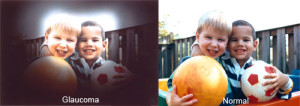Glaucoma Awareness Month – Q & A
Glaucoma is a condition that most everyone has heard of, but quite a bit of confusion still exists.
Since January is Glaucoma Awareness Month, we will be doing a Q&A style post giving some simple facts and debunking some myths about Glaucoma.
If there’s a question I missed feel free to ask. For a far more in-depth discussion on Glaucoma, please visit our glaucoma webpage or the National Eye Institute’s page about Glaucoma.
What is Glaucoma?
Glaucoma is a disease where the internal pressure of the eye causes irreversible damage to the optic nerve that leaves the back of the eye and carries the visual signal to the brain.
How common is Glaucoma?
It is estimated that Glaucoma afflicts about 2.5-3 million Americans… the scary part is; only half of them know they have it!
Does family history play a role?
Absolutely! In the Barbados Eye Study, having Glaucoma in your nuclear family (parents and siblings) increased your risk of developing Glaucoma to as high as 20%. Furthermore, African or Hispanic ancestory also increases the risk 4 fold.
But I don’t feel eye pressure problems?
Unlike high blood pressure which makes you feel funny when elevated, high eye pressure is rarely ever felt unless it gets very, VERY high. This means you have no idea that your own eye pressure is higher or lower than normal without testing.
My eye pressures are always normal at the eye doctor, so I don’t have Glaucoma?
Not so fast. The Baltimore Eye Study sought to answer this question, looking at hundreds of new patients with Glaucoma and looking for trends. In that study, 55% of newly diagnosed Glaucoma patients had normal eye pressure at their first visit and 16% had normal eye pressures throughout the whole study! So no, just because your eye pressure is at a “normal” level doesn’t mean you are safe from this eye disease.
I have been told I have high eye pressures, which must mean I DO have Glaucoma?
No, as well. Many people fall into the category called “ocular hypertensive,” meaning the eye pressure is slightly increased compared to what is considered normal but no active damage is occurring to the optic nerve. A study called the Ocular Hypertensive Treatment Study (OHTS) looked at the risk involved with elevated eye pressure. While high eye pressure is surely a risk factor for Glaucoma, that study found that only 10% of ocular hypertensive patients developed glaucoma damage after 7 years of no treatment.
Therefore, if your pressures are elevated it is important to monitor closely and treat if necessary, but not all individuals with high eye pressures need treatment.
Well if eye pressure doesn’t tell you if I have Glaucoma, what does?
Not a simple question. Diagnosis of Glaucoma is like putting a puzzle together, and your eye pressure is only one piece. In order to fully rule out Glaucoma, some additional information is needed to evaluation your optic nerve health, eye drainage, and peripheral vision among other things. This information is collected with simple, painless in office testing.
How does Glaucoma affect vision?

Glaucoma vision loss is devious. Unlike other eye diseases that cause loss of central vision, Glaucoma causes side vision loss. Peripheral vision loss from Glaucoma is impossible to perceive early in the disease. By the time enough side vision has eroded to become obvious to the patient, you have lost up to 90% of your vision and the disease has reached irreversible end stage with limited treatment options.
That coupled with the lack of actual symptoms from eye pressure has led to Glaucoma being called the “Sneaky Thief of Sight.”
Can it cause Blindness?
Unfortunately yes. Glaucoma is the third leading cause of new blindness in the United States and the second leading cause of blindness worldwide.
I have Glaucoma, what is MY risk of blindness?
A study was once performed where glaucoma was diagnosed and simply followed, not treated. In that study, 29% of those individuals reached blind, end stage disease in 10 years. However, with early diagnosis, proper treatment, and comprehensive monitoring, the risk goes down to only 6% over 15 years.
How is Glaucoma Treated?
While eye pressure alone is not a sure sign that Glaucoma is present or absent, study after study has shown that lowering eye pressure prevents further vision loss. Therefore, the main treatment for Glaucoma is to lower the eye pressure through the use of prescription eye drops or some surgeries in advanced cases.
Since Glaucoma is such a silent disease. The key to keeping this condition in check is routine, preventative care. If you have any risk factors for Glaucoma outline on our website, it is highly advised to receive at least a yearly Comprehensive Ocular Health Exam.
As always, please email with additional questions and take care of those eyeballs!
– Nick Wolf, OD



